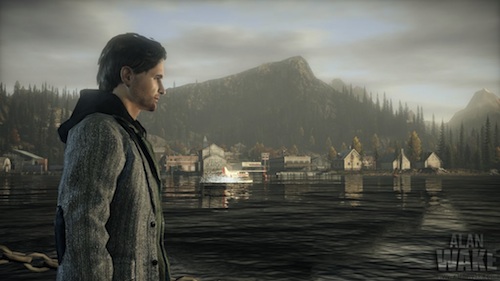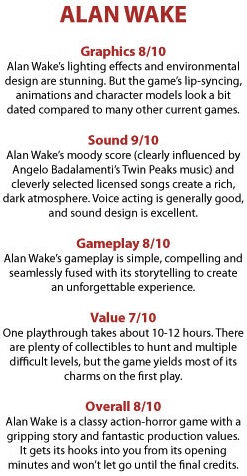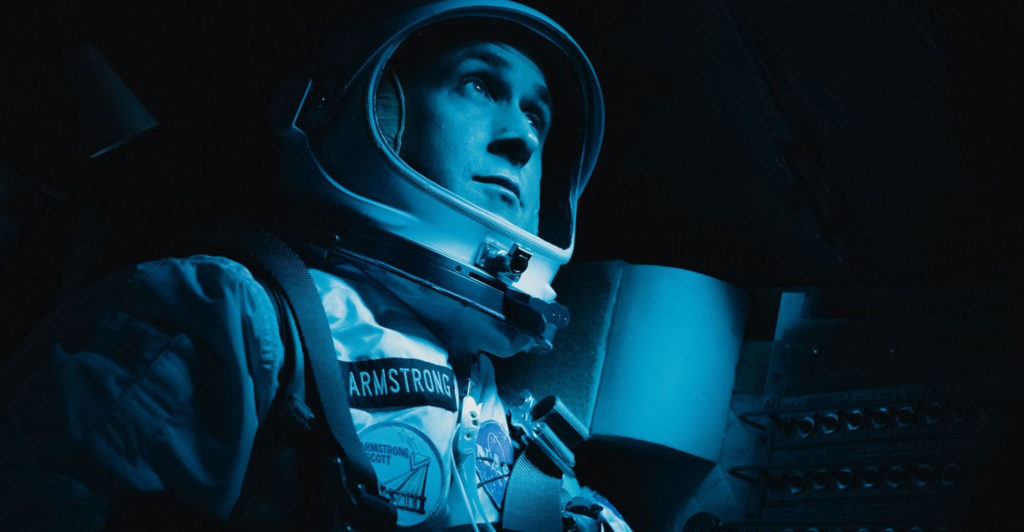
Remedy Software, the small Finnish developer responsible for Max Payne 1 and 2, believes in making its audience wait for its games. Five years after Remedy announced Alan Wake was in development, the long-anticipated horror-action game is finally here as an exclusive for the Xbox 360.
And as usual, the quality of the product more than justifies the time it spent in development. Sure, Alan Wake is not quite as impressive as it might have been if Remedy managed to beat games like Uncharted 2 to market. But even so, no fan of horror fiction or third-person shooters should miss out on it.
Alan Wake has more in common with the Max Payne games than a flawed lead character with a terrible pun for a name. The way Wake moves, the heads-up display, the way a voiceover conveys Wake’s thoughts to the player — these elements of the game are all immediately reminiscent of Max Payne.
Just like Max Payne, Alan Wake is a straight-up action game based on a single, neat gameplay hook. In the case of Max Payne, it was “bullet-time”; in Alan Wake, it’s mixing light sources and bullets to fight off enemies.
The enemies that Wake faces, the Taken, are ordinary townsfolk possessed by a mysterious dark force that shields them from harm. Before Wake can hurt them with bullets, he needs to burn away the darkness that envelopes them with a flashlight. It’s a simple gimmick, but one that works well in practice.
Remedy mixes it up in a number of ways to keep gameplay fresh and ensure the player stays on his toes. The game is exciting right through to the last episode, when its bag of tricks finally runs empty and repetition starts to set in.
Juggling the need to keep your guns loaded and your flashlight powered up as the Taken bear down on you makes for some nailbiting combat set-ups. Provided you have one in your inventory, you can drop a flare to drive back the Taken. That gives the fumbling Wake a few minutes to reload his gun — he’s no superhero in combat, but an ordinary guy who has never handled a gun before.

In Wake’s world, the most powerful weapons are flashbangs and flare guns, which can be used to take out several Taken at once. But they’re in short supply and should be used wisely. In a pinch, you also have the option of running towards the next light source, where Wake’s health will regenerate and the game will be saved.
To add some variety into the mix, Wake will occasionally run into poltergeists. Bulldozers and furniture can come to life and attack the character — and his best defence against them is, once again, light. But the game could’ve done with a little more variety in enemies.
Unlike most traditional survival-horror games, Alan Wake is light on environmental puzzles. There’s some switch-flicking and button-pushing, but the game mostly wants you to enjoy the story and the action. There are also a few driving sequences — though they’re not bad, they’re not particularly necessary or enjoyable.
 Like Max Payne, Alan Wake is an attempt to tell a story infused with pop-culture references in videogame format. Alan Wake, an arrogant, quick-tempered author with writer’s block, is on vacation with his wife in Bright Falls, an idyllic town that has sinister secrets swirling beneath its tranquil surface. As Wake, the player will try to unravel the mystery of the disappearance of his wife and of the supernatural attacks that plague the town when the sun sets.
Like Max Payne, Alan Wake is an attempt to tell a story infused with pop-culture references in videogame format. Alan Wake, an arrogant, quick-tempered author with writer’s block, is on vacation with his wife in Bright Falls, an idyllic town that has sinister secrets swirling beneath its tranquil surface. As Wake, the player will try to unravel the mystery of the disappearance of his wife and of the supernatural attacks that plague the town when the sun sets.
The most obvious touchstones are Steven King’s Secret Window and John Carpenter’s In the Mouth of Madness, both of which deal with the written word becoming horrifyingly real. The quirky townspeople and Bright Falls are straight out of David Lynch’s Twin Peaks.
Alan Wake’s best feature is the elegant way its well-written story is constructed, with a nod to television series such as Lost and 24. The game is divided into six episodes, each of which burns towards an explosive finale and cliffhanger.
Before the next episode begins, earlier events are summed up with a “Previously on Alan Wake” recap. Atari’s recent disastrous Alone in the Dark used this concept first, but it’s a great idea that deserved to be used in a good game.
You’ll get a good feel for the story from listening to Wake’s thoughts and his dialogue with other characters, and from watching the beautiful in-game cinematics. But fragments of the story are also presented through television sets and radios in the game world, as well as loose pages of the novel that Wake can discover. Piecing the puzzle together yourself is a deeply satisfying element of the game.
Though Alan Wake is tagged as a horror game, there’s far too much action for it be as unsettling as, say, Konami’s Silent Hill games. But the story is intriguing and I found myself playing to just find out what had happened to Alan Wake and why. And there are a few cheap but effective monster-in-the-closet scares on the road to the end of the game.
Alan Wake launch trailer:
Visuals are stellar, especially the misty, night-time woods settings where most of the game plays out. The picturesque Bright Falls and its surrounding woods and mountains are rendered in gorgeous detail. And the lighting effects are stunning, too.
Sadly, there are also a few elements of the game that look a little dated. The poor lip-syncing is a major distraction in a game that is as story-driven as Alan Wake. And many of the character animations are stiff and listless compared to those in state-of-the-art third-person action games like Uncharted 2 or even the ageing Gears of War 2.
These few flaws aren’t enough to hold Alan Wake back from being one of the top third-person action games on the market at the moment. It’s another great game in what is turning out to be one of the best gaming years I can remember. — Lance Harris, TechCentral
- Alan Wake is only available on Xbox 360
- Subscribe to our free daily newsletter
- Follow us on Twitter or on Facebook




